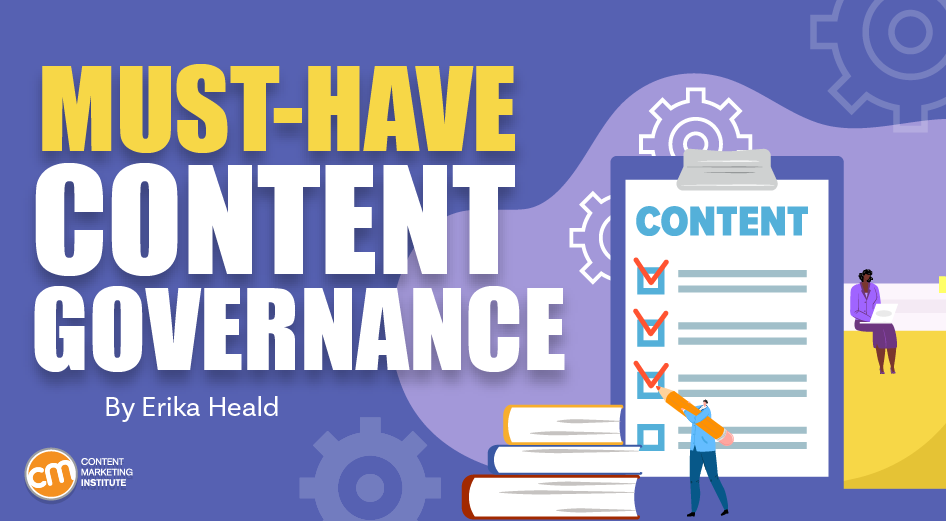
When you hire architects to design a house, they don’t just give the interior and exterior drawings to the construction crew and call the project complete. To ensure that the finished product meets everyone’s expectations, they provide comprehensive specifications for the team.
So why do many content marketers expect a content strategy to do all the heavy lifting on its own?
While a detailed content strategy is the foundation for a successful content marketing program, it’s just the starting point. Putting the strategy to work to meet your business goals requires building a governance framework that supports it.
What is content governance?
Content governance is the collection of processes, workflows, templates, frameworks, and guidelines an organization uses to manage its content. At its core, it takes all those must-dos internalized by your head of content and turns them into content consistency tools.
It helps you deliver more seamless customer experiences across channels. It also takes the content team out of the content police business.
Some content creators balk at constraints on their creativity when they must adhere to governance standards. However, content governance puts the content strategy into action. Without this framework, random acts of content abound.
Every content team has different needs. However, every content governance toolkit needs these documents.
Documented content workflows and processes
Detailing content marketing workflows clarifies team roles, responsibilities, and progression of tasks from ideation to publication. The goal is to streamline content production while ensuring that content reflects the content strategy and meets your quality standards. Two of the most common workflows are related to content requests and editorial.
Editorial workflows
A documented editorial workflow can be as simple as a flowchart showing the people and tasks in the content life cycle. It should include each step from ideation through drafting, editing, approval, and publication. It also should note the average time for each step.
Content request workflows
A workflow for content requests allows you to adopt a consistent approach to organizational asks. A document template, sometimes referred to as an intake form, can manage this workflow. It ensures that you receive all the information to evaluate an incoming request. It can also help thwart last-minute requests while ensuring that any new content aligns with the overarching content strategy.
Following this flow chart, the idea is shared in an intake form, which goes to an editorial board for review. If it decides yes, the idea should be added to the content calendar and assigned to the content creator and workflow. If the editorial review ends in a no, the requester is notified by email and can revise the idea on the intake form so the editorial board can review it again.
Content templates: Your blueprints for quality
Content templates are not creativity’s enemy. They are not fill-in-the-blanks recipes for bland, basic content. Content templates work as reusable blueprints for consistently creating high-quality content. They detail all the elements for publishing and promoting every content project.
Content brief template
A comprehensive content brief includes the objective, target audience, key messages, and call to action. It can be a standalone template submitted as part of the intake workflow, or you can include it as a component of other content submission templates.
Content submission templates
Publishing a piece of content involves more than securing the image, video, or copy. The elements vary by channel, too. Create content submission templates for each of your most common formats (e.g., blog posts, webinars, emails, e-books).
Content distribution templates
The best way not to forget an important content distribution opportunity is to have a template that outlines the possibilities. It should detail prioritization criteria and map content formats to each channel.
Strategic supporting documents drive alignment
Along with templates and workflows, reference materials and resources can help align content with the strategy. Among the supporting documents to include:
A content style guide
Even if you use a third-party guide, such as AP Style, you should still draft your brand’s content style guide. In addition to identifying brand-specific style, it can share your brand voice chart and how to apply it. Consider the style guide as the basic operating manual for your content organization.
An editorial calendar
In addition to helping you plan the team’s workload, an integrated editorial calendar gives everyone in the organization visibility into your priorities. It aligns the content team’s work with the content strategy, mapping activities to business cycles and highlighting key dates.
Implementing content governance
You can get started with content governance with the same tools already used in your organization to collaborate and share documents. As your content team grows and its output increases, consider adopting technology platforms designed for content teams.
With your governance frameworks in place, you can also turn to generative AI to scale your efforts. Generative AI is particularly well suited for applying templates for content repurposing and comparing content against your guidelines.
The final step in implementing content governance is identifying and tracking meaningful content metrics. Your governance activities should increase content engagement and conversion key performance indicators.
Content governance can seem intimidating, but it’s a great way to democratize content creation. A shared governance toolkit helps your organization create good content that fits your brand and strategy. It allows you to unlock a range of perspectives and expertise throughout the company, increasing the content program’s potential.
For a deeper look at aligning metrics with business objectives and demonstrating content’s value to stakeholders, plus examples of the governance documentation mentioned throughout this piece, watch Erika’s recent CMI webinar on content strategy.
HANDPICKED RELATED CONTENT:
Cover image by Joseph Kalinowski/Content Marketing Institute
